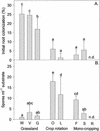Impact of land use intensity on the species diversity of arbuscular mycorrhizal fungi in agroecosystems of Central Europe
- PMID: 12732553
- PMCID: PMC154529
- DOI: 10.1128/AEM.69.5.2816-2824.2003
Impact of land use intensity on the species diversity of arbuscular mycorrhizal fungi in agroecosystems of Central Europe
Abstract
The impact of land use intensity on the diversity of arbuscular mycorrhizal fungi (AMF) was investigated at eight sites in the "three-country corner" of France, Germany, and Switzerland. Three sites were low-input, species-rich grasslands. Two sites represented low- to moderate-input farming with a 7-year crop rotation, and three sites represented high-input continuous maize monocropping. Representative soil samples were taken, and the AMF spores present were morphologically identified and counted. The same soil samples also served as inocula for "AMF trap cultures" with Plantago lanceolata, Trifolium pratense, and Lolium perenne. These trap cultures were established in pots in a greenhouse, and AMF root colonization and spore formation were monitored over 8 months. For the field samples, the numbers of AMF spores and species were highest in the grasslands, lower in the low- and moderate-input arable lands, and lowest in the lands with intensive continuous maize monocropping. Some AMF species occurred at all sites ("generalists"); most of them were prevalent in the intensively managed arable lands. Many other species, particularly those forming sporocarps, appeared to be specialists for grasslands. Only a few species were specialized on the arable lands with crop rotation, and only one species was restricted to the high-input maize sites. In the trap culture experiment, the rate of root colonization by AMF was highest with inocula from the permanent grasslands and lowest with those from the high-input monocropping sites. In contrast, AMF spore formation was slowest with the former inocula and fastest with the latter inocula. In conclusion, the increased land use intensity was correlated with a decrease in AMF species richness and with a preferential selection of species that colonized roots slowly but formed spores rapidly.
Figures



References
-
- An, Z. Q., J. W. Hendrix, D. E. Hershman, R. S. Ferriss, and G. T. Henson. 1993. The influence of crop-rotation and soil fumigation on a mycorrhizal fungal community associated with soybean. Mycorrhiza 3:171-182.
-
- Bethlenfalvay, G. J. 1993. Mycorrhizae in the agricultural plant-soil system. Symbiosis 14:413-425.
-
- Bever, J. D., P. A. Schultz, A. Pringle, and J. B. Morton. 2001. Arbuscular mycorrhizal fungi: more diverse than meets the eye, and the ecological tale of why. BioScience 51:923-931.
-
- Bidartondo, M. I., D. Redecker, I. Hijri, A. Wiemken, T. D. Bruns, L. Domínguez, A. Sérsic, J. R. Leake, and D. J. Read. 2002. Epiparasitic plants specialized on arbuscular mycorrhizal fungi. Nature 419:389-392. - PubMed
-
- Blaszkowski, J. 1993. Comparative studies on the occurrence of arbuscular fungi and mycorrhizae (Glomales) in cultivated and uncultivated soils of Poland. Acta Mycol. 28:93-140.
Publication types
MeSH terms
LinkOut - more resources
Full Text Sources
Other Literature Sources

